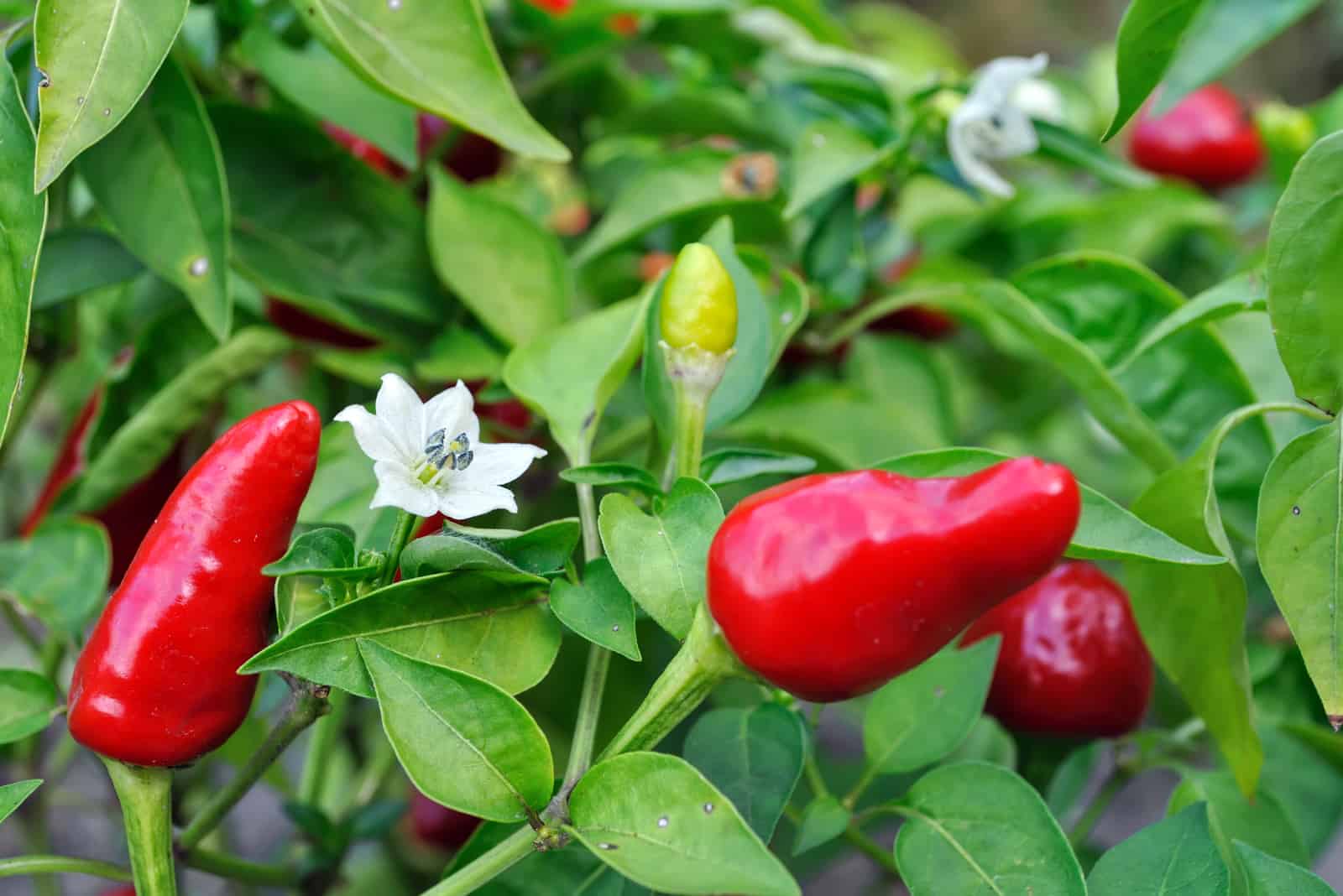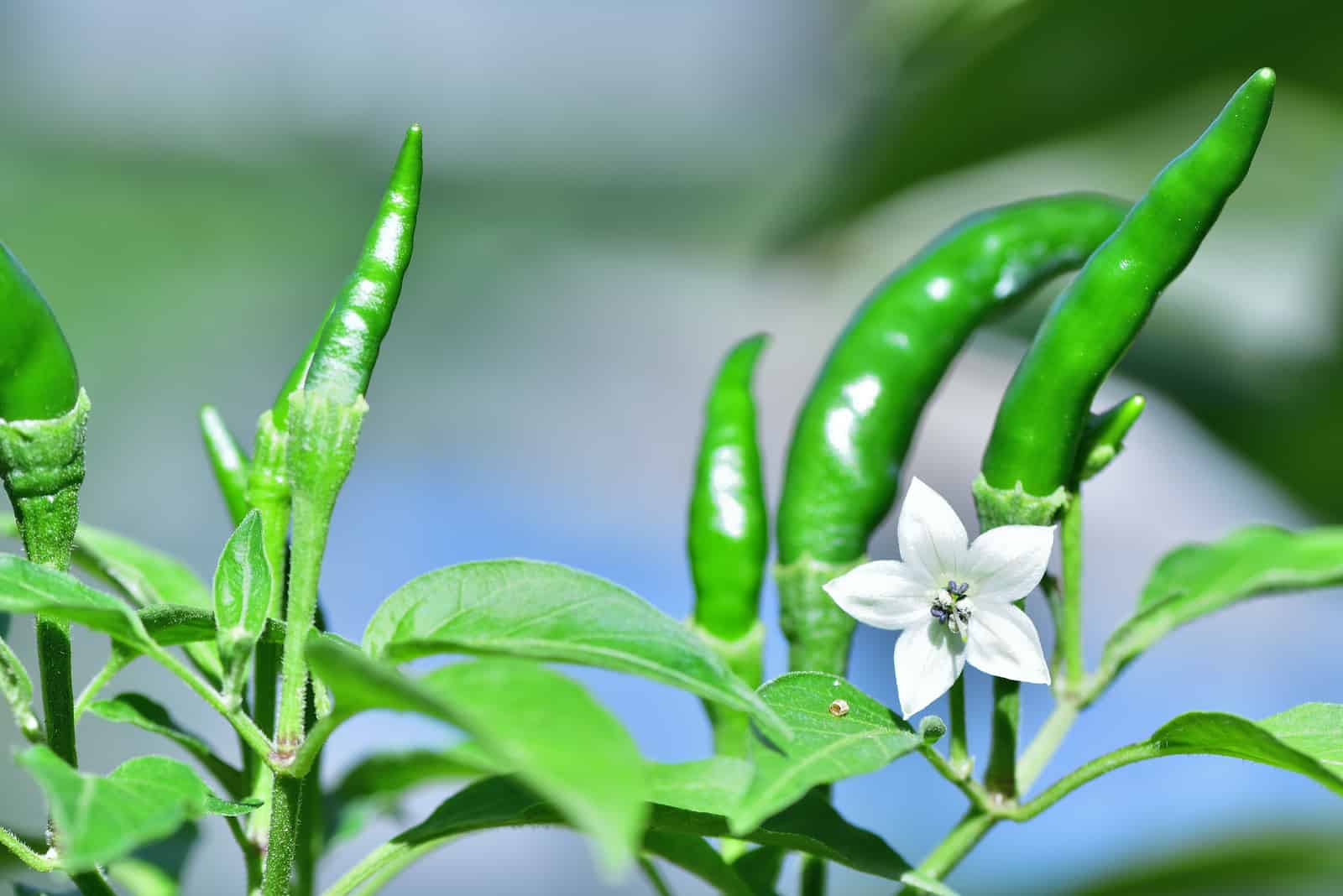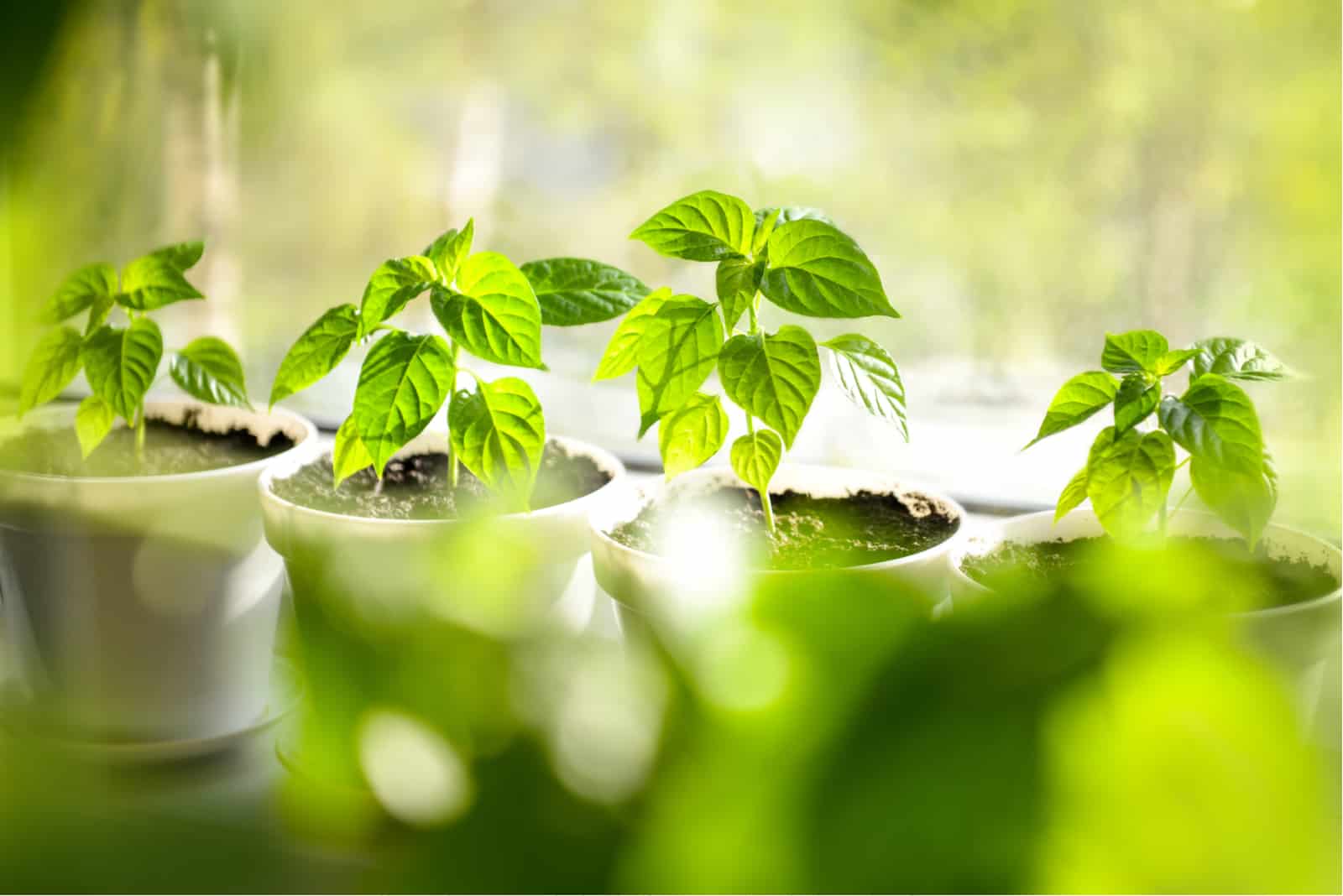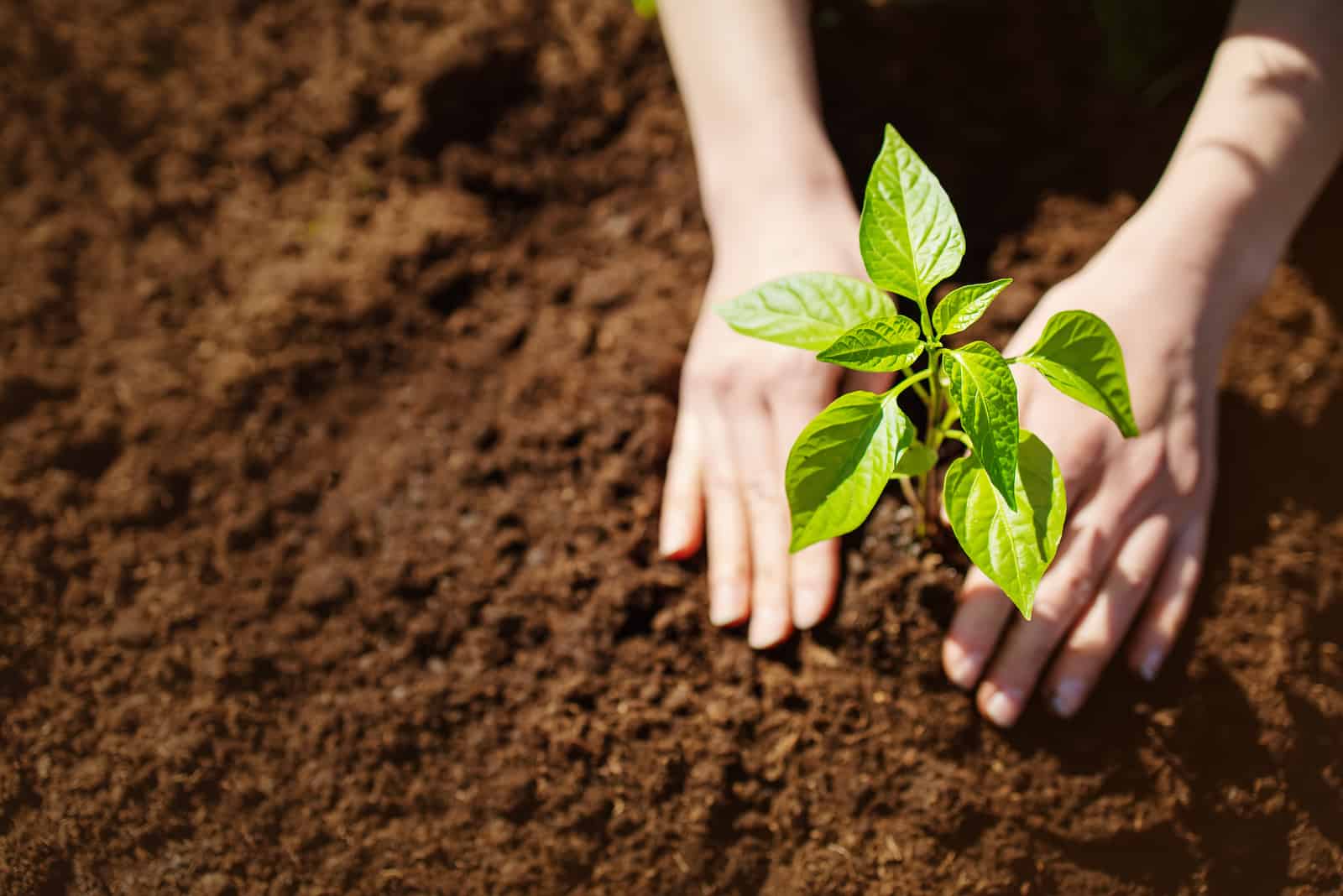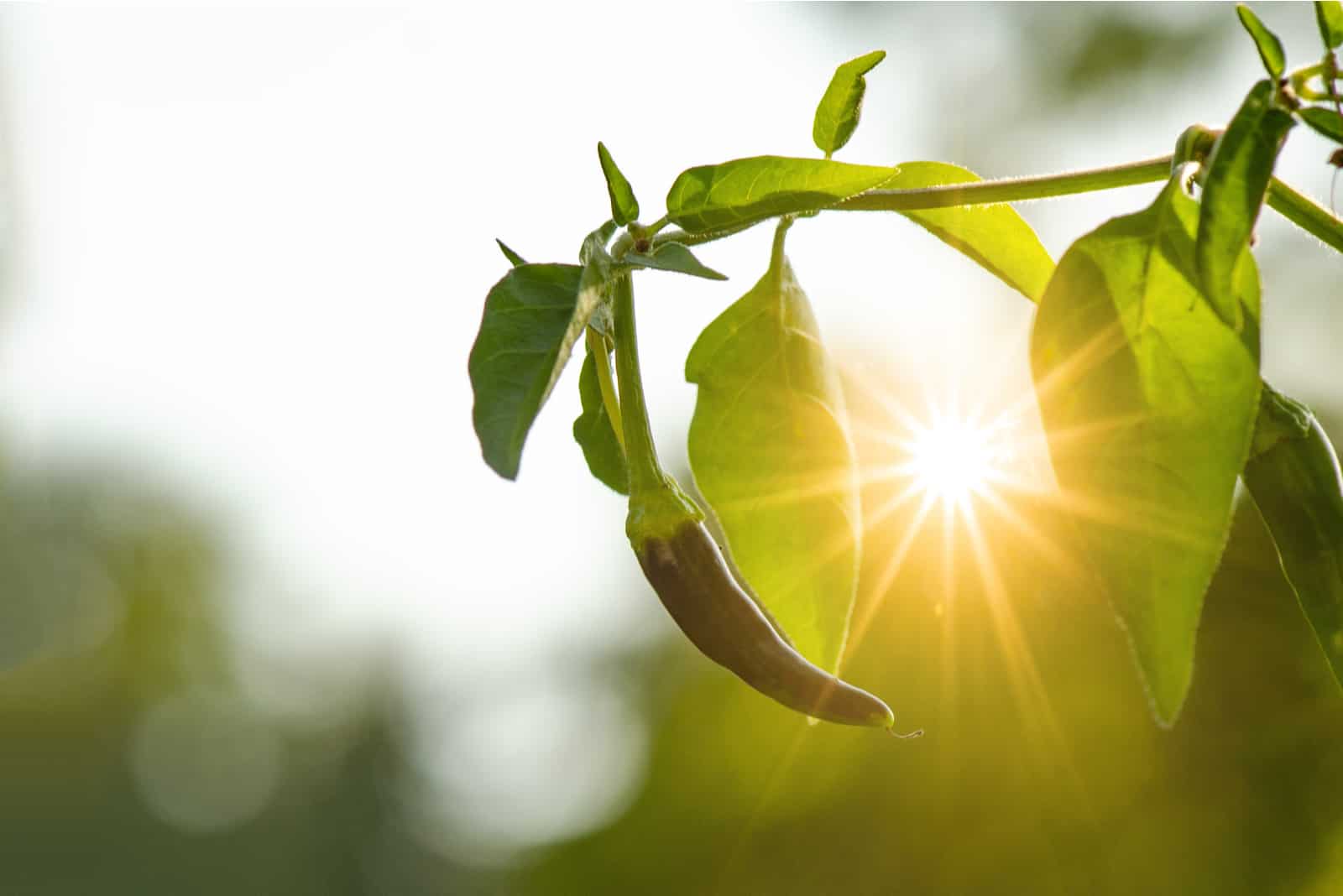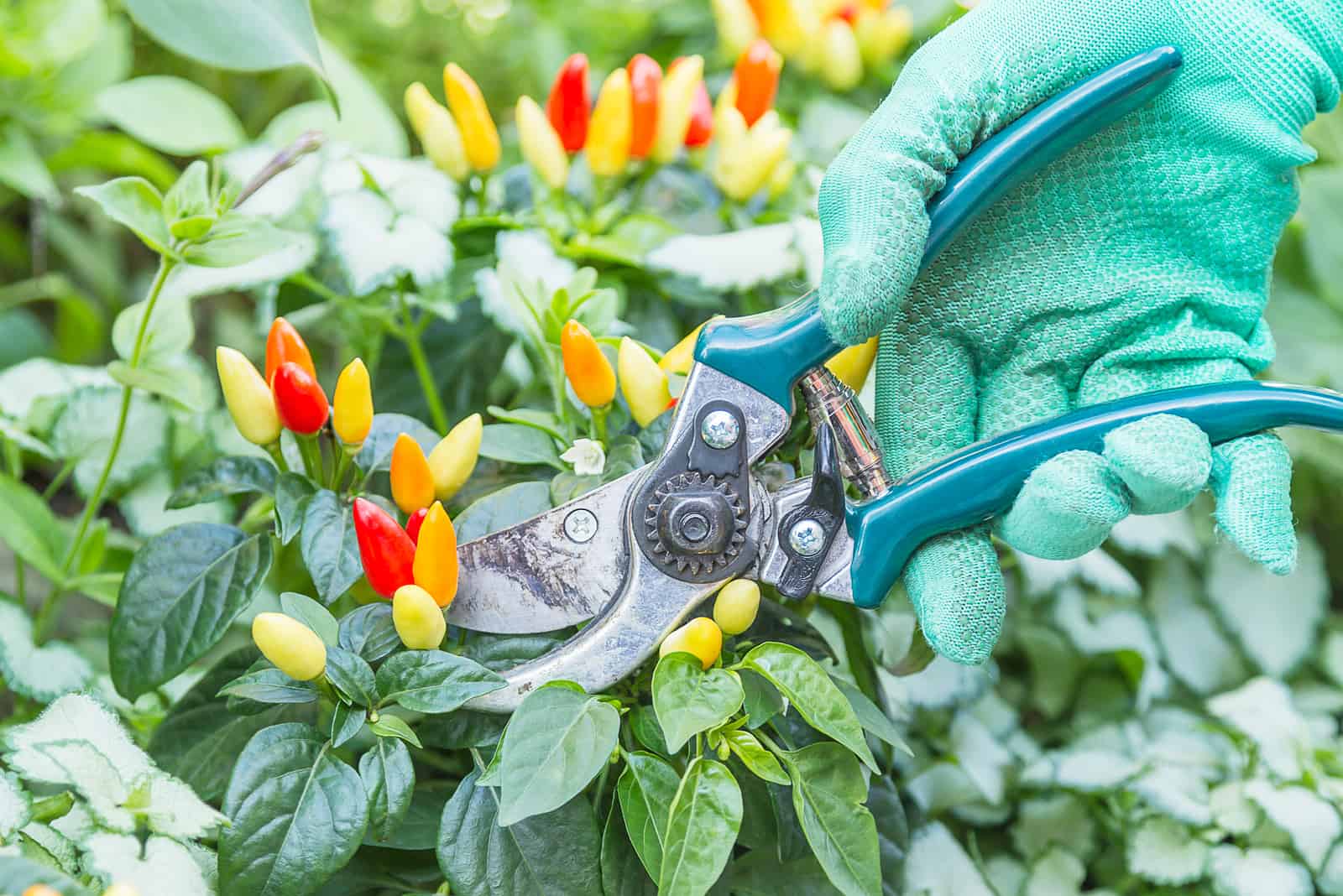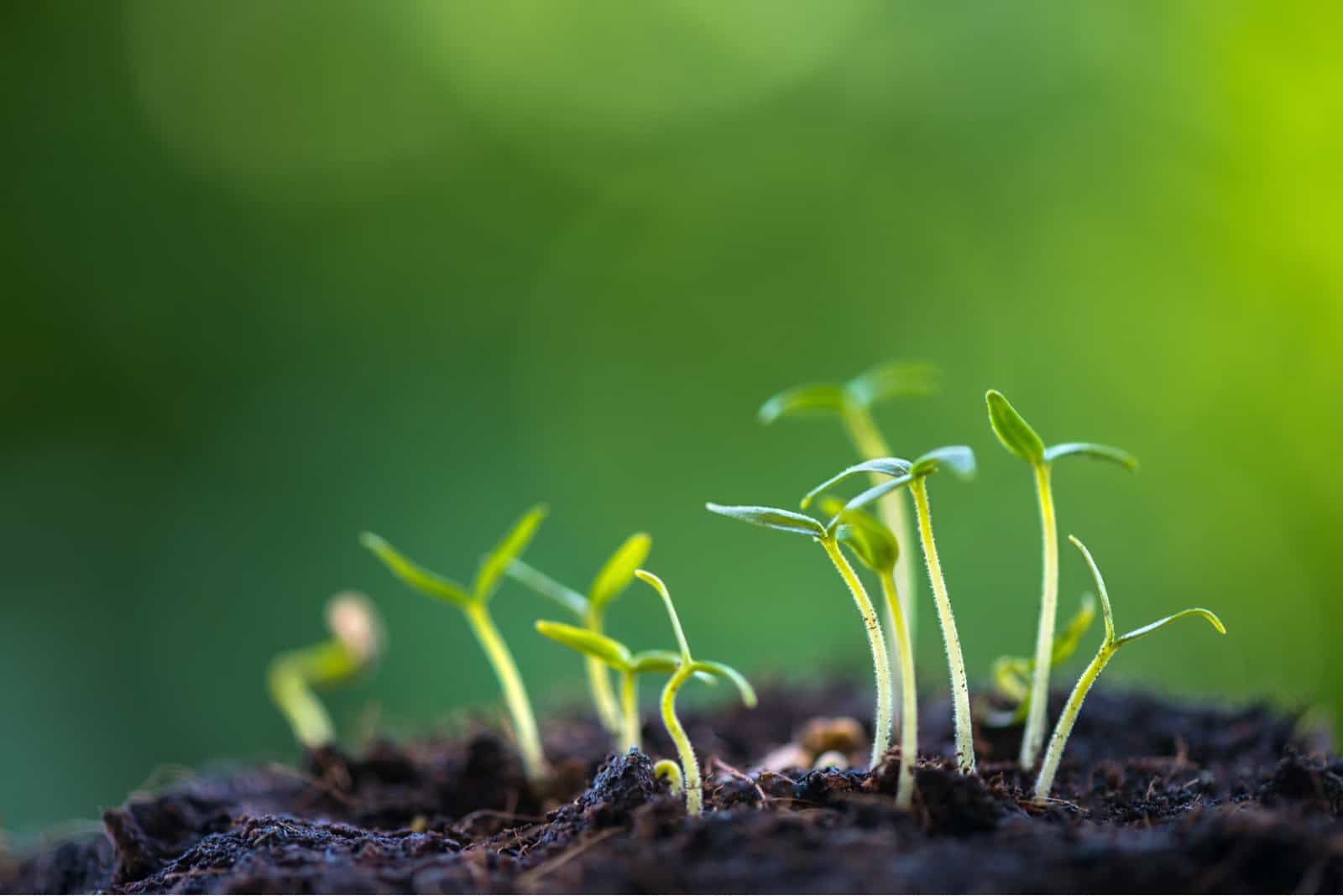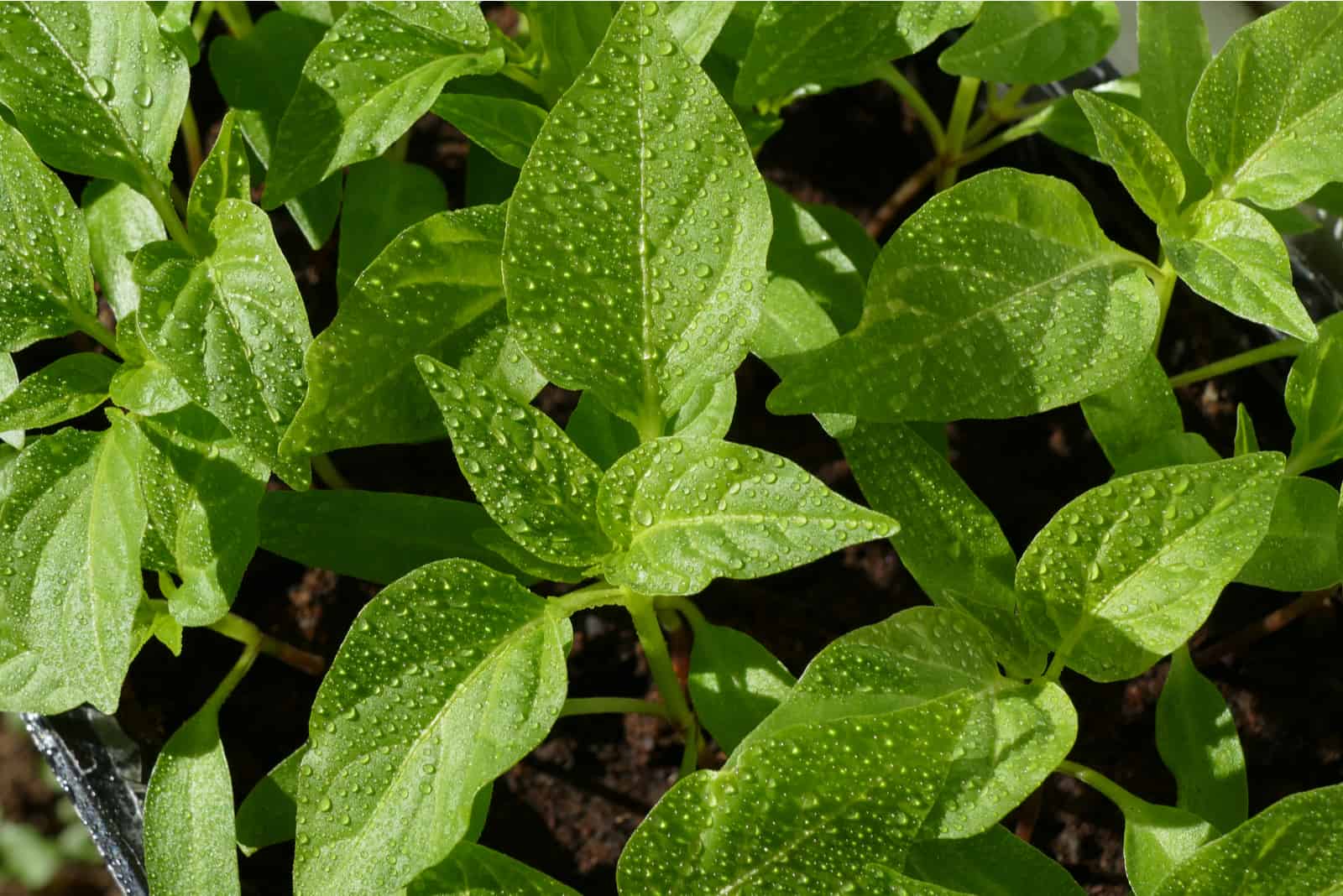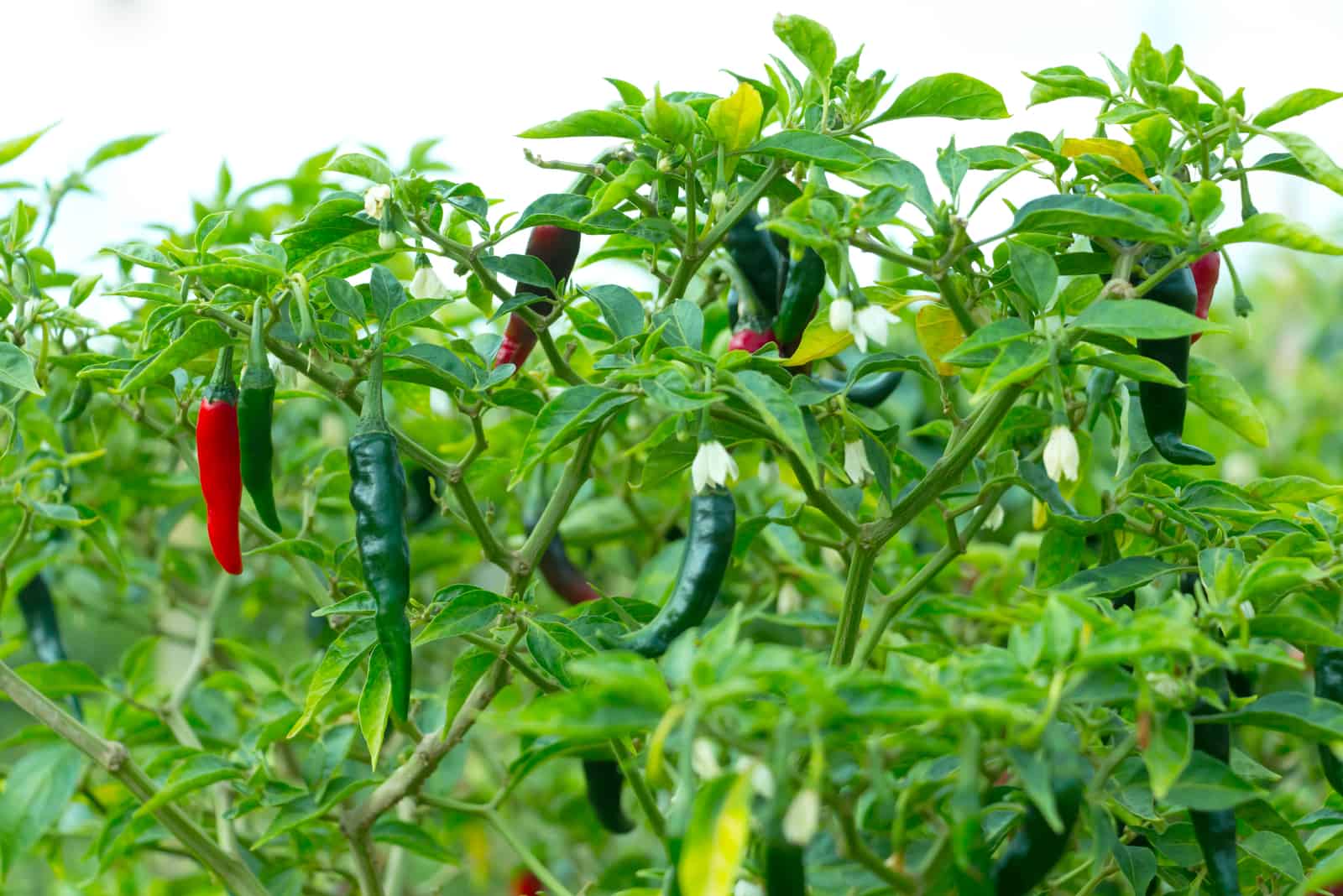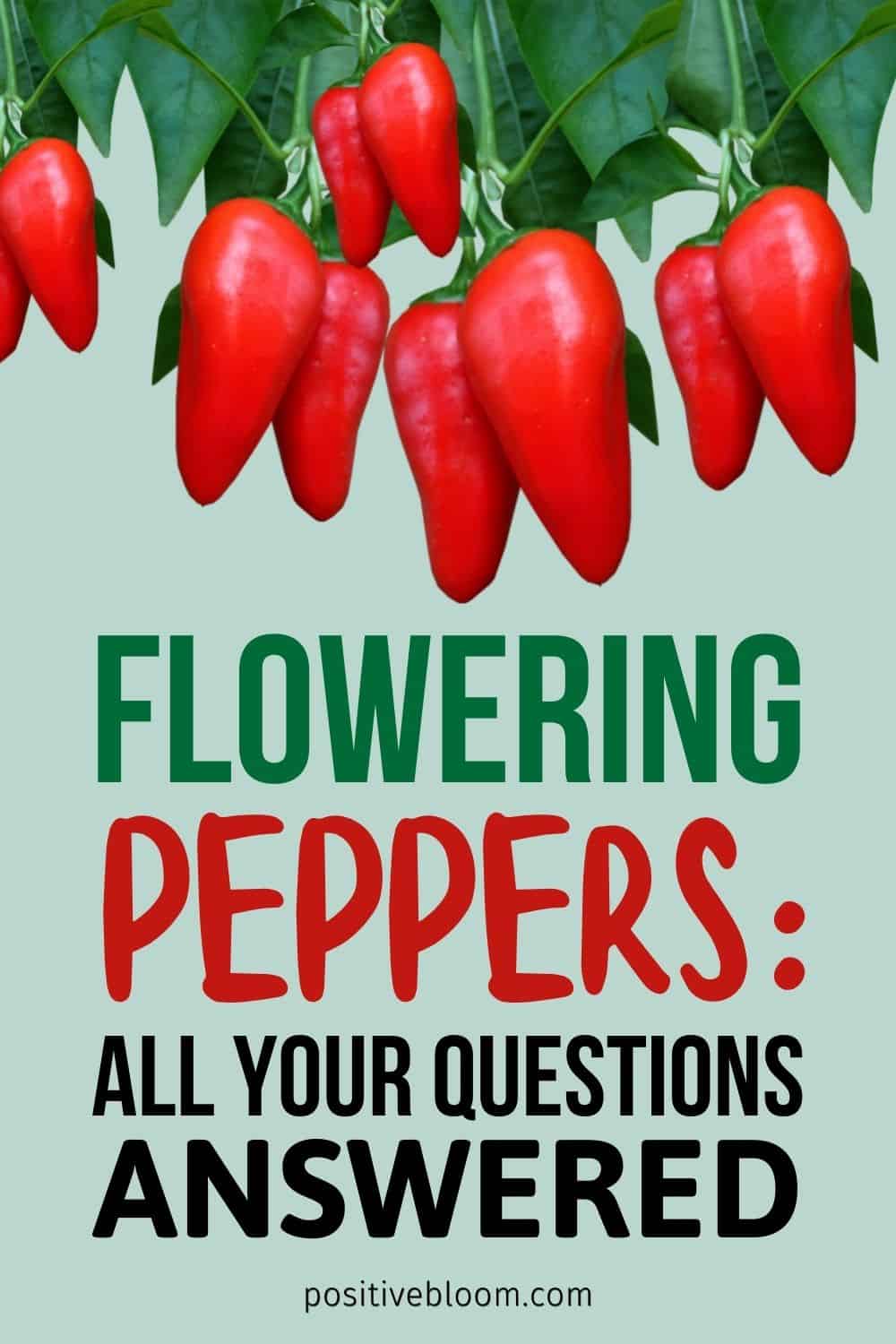Everyone loves peppers, whether they’re hot or sweet. But I bet you’ve never given much thought to flowering peppers, perhaps because you didn’t even know that peppers flower, or you just ignored them because they don’t improve the beauty of your reading room or office.
This is why it’s good to know everything you can about peppers before you buy some to grow yourself.
Peppers belong to the Capsicum genus (Solanaceae family) and have a long growing season. But if you overwinter your peppers, the long growing season shouldn’t concern you.
However, if you want a pepper to keep your tomato plant company in your greenhouse, you’ll need all the info in our pepper care guide.
Peppers are annual plants, mostly because they can’t survive harsh winter conditions.
In this article, you will find lots of important information about flowering peppers: why they flower in the first place, how to get the best out of every pepper, and a list of the best peppers to grow.
Flowers On Pepper Plants
Whether they’re white, purple, or green, knowing everything about pepper flowers is extremely important because they eventually turn into fruit. There are no male and female peppers, and no male and female flowers.
Unlike cucumbers or watermelons, which have male and female flowers on the same plant, peppers possess both male and female parts in a single flower. This means you only need one pepper plant to get fruit.
However, if you want to enjoy the sweet or hot taste of peppers, they first need to be pollinated.
Pollination
Pollination is usually done by our little friends from the insect world. Bees and bumble bees land on a male flower part, get some pollen stuck to them, and then transfer it onto a female part.
This process is incredibly important!
Peppers are self-pollinating plants, and a single plant only needs a bumble bee or a strong gust of wind to be ready to produce fruit.
You don’t need to avoid cross-pollination, but if you want you can always try hand-pollination, as long as you don’t find it too tedious.
Hand-pollination is also an option if you grow peppers indoors. But keep in mind that the fruit will taste sweeter and grow bigger if the female flower parts are thoroughly pollinated.
Flowering Pepper Plant Care Guide
Every plant has specific needs, and if you meet them all you will notice your plants growing big and strong.
Flowering peppers are no different. In the following section, you will find the requirements every pepper grower needs to know before starting their vegetable garden.
Light
If you want to enjoy spicy or sweet peppers, you will have to be careful with light requirements.
Pepper plants need full sun in order to grow and bear fruit, so be sure you plant them somewhere they can be exposed to sun for 6-8 hours a day.
If you want to grow an indoor vegetable garden, growing lights are something you need to take into consideration. Peppers need a lot of light, so you should buy good grow lights that can run for 14-16 hours per day.
The amount of time depends on the type of grow light you are using.
Water
Watering requirements are a bit more complicated than pepper sunlight needs. Generally speaking, you should water your peppers once a week, but this amount can vary depending on the wind, the temperature, the pot in which the pepper is placed, and the actual size of the pepper.
If you live in an area with a drier climate and the temperature gets too high, you might even need to water the peppers every day. However, you should let the soil dry a bit between waterings.
Pro tip: mulch your garden with clippings of lawn grass or straw as this will reduce the need for watering. After rain, the water will pass through the mulch and the pepper plant will be protected from heat, which will slow down evaporation.
This is usually done with in-ground plants, but there’s nothing to stop you from trying this method on your potted flowering peppers.
Make sure to let us know how it went!
P.S. Avoid overwatering at all costs!
Soil And Fertilizer
Peppers require neutral or slightly acidic (pH level between 6.2 and 7.0) soil. However, they can tolerate alkaline soils up to the 7.5 pH level.
There is a difference if you’re growing your peppers in in-ground gardens or pots.
For in-ground gardens, you should mix a few inches of compost with the existing soil. Compost helps retain moisture and enriches the soil with organic content.
For potted peppers, use a fluffy potting mix that is rich in organic content and nutrients. You should also make sure that the soil is well-drained because potted peppers are more susceptible to water-clogging.
The key is to put mulch around your peppers wherever you planted them because this helps the soil retain the ideal amount of moisture (something I only found out recently).
Fertilizer Requirements
If you want higher fruit production from your peppers, you should be careful about the fertilizers you use.
Not all fertilizers are the same, and so you should use nitrogen fertilizer. Other important ingredients are phosphorus (important for energy storage) and potassium, which helps your flowering peppers fight off diseases.
Depending on the type of soil you have, you might also want to add some magnesium, calcium, or even iron.
Another important thing is to follow the instructions when applying fertilizer, as too much fertilizer can lead to fertilizer burn. The foliage of your pepper may turn yellow and drop off and the growth of the plant may slow down.
A general rule is to apply fertilizer immediately after the transplant, and then every couple of weeks during the growing season.
Temperature
Most pepper varieties are very sensitive to temperature, and they don’t like anything below perfection.
The ideal temperature slightly varies between different varieties: bell peppers prefer temperature within the range of 70 and 80°F (21-26°C), while hot peppers prefer slightly higher temperatures of 70-85°F(21-29°C).
Most peppers cannot withstand temperatures higher than 90°F (32°C), but jalapenos and other hot peppers varieties handle hot summer days quite well, and will bear fruit if you take care of them.
Transplantation
If you tried transplanting your peppers before and everything seemed to be going right, and then one day the transplant simply didn’t take, what happened?
One of the main reasons is the cold. Peppers are easily transplanted, but they hate cold soil, so you should only transplant them when all chances of soil freezing have passed and the soil temperature is above 60°F (15°C).
As soon as you look at your pepper plant, you will know whether or not it will survive the transplant. Leggy peppers with weak stems and only one or two leaves are probably not going to survive transplant shock.
The perfect time to transplant your peppers is when they’re 6-8 weeks old, before they start producing flowers or fruit.
Flowering peppers will probably survive, but transplantation may lead to blossom drop and a delay in fruit production.
Before transplanting, be sure to prepare the soil of your pepper’s new home. Add fertilizer and compost (following the instructions on the box) which will provide the nutrients and organic content necessary to your pepper plant.
Then simply pick up the pepper plant, being very careful not to damage the stem, and place it in the soil. Pepper plants may stop growing for a few days after the transplant, and to avoid this it’s a good idea to transplant them on a cloudy day.
Time Of Pruning
Pruning your peppers is not something absolutely necessary, but it is beneficial. However, if you do decide to prune your pepper plants, you should know that timing is essential.
There are three seasons for pruning peppers: early, mid, and late season.
• Pruning peppers in the early season allows them to branch more and improves their root system and air circulation. Simply cut off the top of the young plant to get a bushier pepper.
Hot peppers like jalapeno peppers and habaneros love early pruning, but bigger varieties like bell pepper plants don’t need it, and it may actually do more harm than good.
When you see early pepper flowers, it’s a good idea to cut off some early flower buds because this will improve the vegetative growth of the plant and allow it to bear more fruit later on.
In order to fight fungal infections and increase aeration, cut off some lower leaves and your plant will cheer up in no time.
• Mid-season pruning is done to fight off pests and disease and keep the stems from becoming overloaded with leaves.
• Pruning pepper plants in the late season speeds up the ripening process, makes colors change faster, and ensures fruit is produced before the freezing period.
If you still have some questions about pruning peppers, you can always check this video for more information.
Growth Cycle
If you have decided to grow pepper plants, but aren’t quite sure how to get from seed to a flowering pepper that will produce fruit, then this section is important. It will teach you everything you need to know about the growth stages of a pepper plant and help you improve your agricultural skills.
• The first stage is seed germination. Cover the pepper seed with 0.25 inches (0.6 cm) of moist soil or seed starting potting mix, and wait for it to sprout. Depending on the variety of the pepper plant, it may take one to six weeks for you to see two pointed leaves.
• The second stage is plant growth. After 6 weeks, pepper plants have a fully developed root system, so you should move them to another container (pot size at least 4 inches (10 cm) in diameter), and after 8 weeks they will be ready for transplanting.
• The pollination stage is where things really start to happen. Peppers need to be pollinated in order to bear fruit, and this is where insects and the wind come into play. Peppers can self-pollinate, while insects help with cross-pollination.
• After pollination, the next stage is setting fruit. When the ovary is fertilized, the fruit starts to form. The fruit is hollow inside where the seeds are formed.
•The last stage is the ripening of the fruit. Immature peppers are always green, but mature, full size peppers start changing their color because the chlorophyll breaks down. The most common color of peppers is red, but they can also be orange, yellow, green, or even purple.
The length of the growth cycle is different for each variety, and it can take anywhere between 2-5 months after the transplant for the plant to fully mature, so knowing when to harvest habanero peppers, for instance, is important for your hot sauces.
Common Problems With Pepper Plants Flowers
Flowering peppers are an every-day thing. But what happens if your pepper doesn’t produce any flowers or produces flowers that soon drop?
Read on to learn about the common issues with flowering peppers and how to avoid and deal with them.
Why A Pepper Plant Doesn’t Flower
One of the main reasons pepper flowers don’t appear is the weather. They need full sun and warm temperatures to produce flowers and eventually fruit. Cold weather stunts the growth of pepper plants, which reflects on their flower production.
Another reason for peppers not producing any flowers may be blossom end rot. Night temperatures are over 75°F (23°C) and calcium deficiency causes the end parts of the pepper blossom to turn brown or black – and the outcome is no fruit.
Improper nutrition, such as too much nitrogen and too little potassium and phosphorus, may result in beautifully green plants, but with no flowers or fruit.
Pepper plants are not usually a decorative plant, so cut down on nitrogen.
Flower Drop
One of the main reasons for flowers falling off is high temperatures. Peppers love moderate temperatures, and though they can tolerate 100°F (37°C) heat, it can’t be for too long.
Overwatering your peppers may lead to a number of problems, one of which is flower drop. Peppers like moisture, but not being drowned in water, so keep this in mind when you water your carolina reaper or ghost pepper.
Humidity levels that are inconsistent may lead to less pollen and blossom drop, which leads to no fruit. If you want to harvest peppers, research the specific humidity requirements for your variety.
FAQ
Below, you will find the answers to your frequently asked questions that were brought to our attention.
I bet some of the answers will surprise you!
What triggers flowering in peppers?
Low nitrogen levels in the form of nitrates triggers flowering. Flowering can also be triggered by a pot one size too small, which isn’t good because the root system will not develop properly.
How can I prevent peppers from flowering?
Pepper plants won’t flower if there is too much nitrogen in the soil and not enough potassium and phosphorus.
If you want to stop your pepper plant from premature flowering, use a pot big enough for its root system and don’t overwater it. Keep the soil moist and rich in organic matter and nutrients and you won’t lack peppers for your hot sauce or salads.
What is the lifespan of a pepper plant?
The average lifespan of peppers is 1-3 years, but certain varieties can live more than 10 years if you take good care of them.
Sweet peppers, bell peppers, and jalapenos have a life expectancy of 1-3 years, while habaneros and ghost peppers can live 3-5.
Therefore, if you take care of them, you’ll have the same pepper plant next year.
Final Thoughts
In the end, we can say that growing peppers doesn’t require too much effort. There are a few things you need to keep in mind, like not overwatering or over-fertilizing and giving your peppers enough light, but other than that flowering peppers require no additional care.
Maybe some bell pepper plants will require staking if the fruit production is particularly high.
Now all you need to do is go to a nursery and buy a potted pepper plant to start or add to your vegetable garden.
Good luck, and until next time!
Like this post? Please share or pin it for later!

